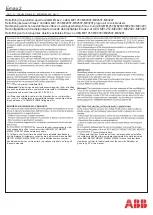
SECTION 1 -lntroduction
These i nstructions provide the maintenance procedures
and describe the operation of the
800
thru
2000
amp frame
size type AKA low voltage power circuit breakers listed in
Table
1 .
The proper use, care, and maintenance of these break
ers is a prime safety consideration for the protection of
person nel, as well as a means of minimizing equipment
damage when faults occur. Persons who apply, use , and
service these breakers will acquire the knowledge they
need by gaining the information contained in these instruc
tions.
1 . 1
INSPECTION AND MAINTENANCE
Breakers should be cared for under a systematic main
tenance program. Taking each breaker out of service
periodically for inspection and maintenance is an excellent
means of establishing high service reliability. It is good
policy to have one or more spare breakers to i nstall in place
of breakers requiring maintenance. Keeping a stock of
recommended renewal parts will insure that maintenance
work can be done quickly.
How frequently an individual breaker should be in
spected will depend on the circumstances of its use. It
would be well to inspect any breaker at least once a year. If
it is frequently operated, operated under severe load condi
tions, or i nstalled in an area of high humidity or a dusty ,
dirty atmosphere, inspections should be more often. In
spections might be monthly under adverse conditions.
Always inspect the breaker after a short-circuit current
has been i nterrupted .
4
SAFETY P RECAUTION
BEFORE INSPECTING OR BEGINNING ANY
MAINTENANCE WORK ON THE BREAKER, IT
MUST BE DISCONNECTED FROM ALL VOLT
AGE SOUR CES, B O TH P O WER AND CON
TROL, AND BE IN THE "OPEN" POSITION.
A basic i nspection should consist of the following:
a. Visual Check - Look for dirt, grease or other foreign
material on any breaker parts. Check insulating surfaces
for conditions that could degrade i nsulating properties
(cracks, overheating, etc.). Also check for loose hardware
and components on the bottom of the b reaker compart
ment. Loose or damaged control wiring and similar
problem areas should also be checked.
b. Operation - Observe a few close-open operations
using the operating or maintenance handle. If a breaker is
seldom operated such that it remains open or closed for a
period of six months or more, it is recommended that it be
opened and closed several times i n succession.
c. I nterlocks - During the Operational check verify the
safety interlocks are properly working.
d . Arc Chutes and Contacts - I nspect the condition of
the arc chutes and contacts. Look for excessive burning or
breakage. Check the amount of contact depression or
wipe when the breaker is closed.
e. Accessories - Verify that the various accessories are
working properly.
f. The performance of the solid-state current trip devices
may be checked with a suitable test set. Check elec
tromechanical devices for positive trip in accordance with
the instructions in their Maintenance Manual, G E l
86 1 57.
1 .2
RENEWAL PARTS
The AKA breakers contain a variety of parts and as
semblies. Many of these are available as replacement
parts when the need arises. See publication G E F
4527,
Renewal Parts, for a complete listing of these parts.
www
. ElectricalPartManuals
. com






































